Leader-Member Exchange and Transformational Leadership Methods
VerifiedAdded on 2023/03/31
|9
|1586
|156
Essay
AI Summary
This essay provides a comparative analysis of two prominent leadership theories: Leader-Member Exchange (LMX) and Transformational Leadership. It delves into the nuances of each theory, examining their approaches to decision-making, teamwork, and overall work performance. The essay highlights the advantages and disadvantages of both LMX, which emphasizes employee involvement and collaborative decision-making, and Transformational Leadership, which centers on a leader-driven approach with less emphasis on teamwork. Ultimately, the essay concludes that while both methods have their merits, LMX may offer more benefits in terms of fostering productivity and a positive work environment, while transformational leadership may be more suitable for situations requiring timely execution. The document is available on Desklib, a platform offering a wide range of study resources for students.

LEADERSHIP METHODS 1
Leadership
Student’s affiliate:
Institution affiliate:
Course:
Date:
Leadership
Student’s affiliate:
Institution affiliate:
Course:
Date:
Paraphrase This Document
Need a fresh take? Get an instant paraphrase of this document with our AI Paraphraser
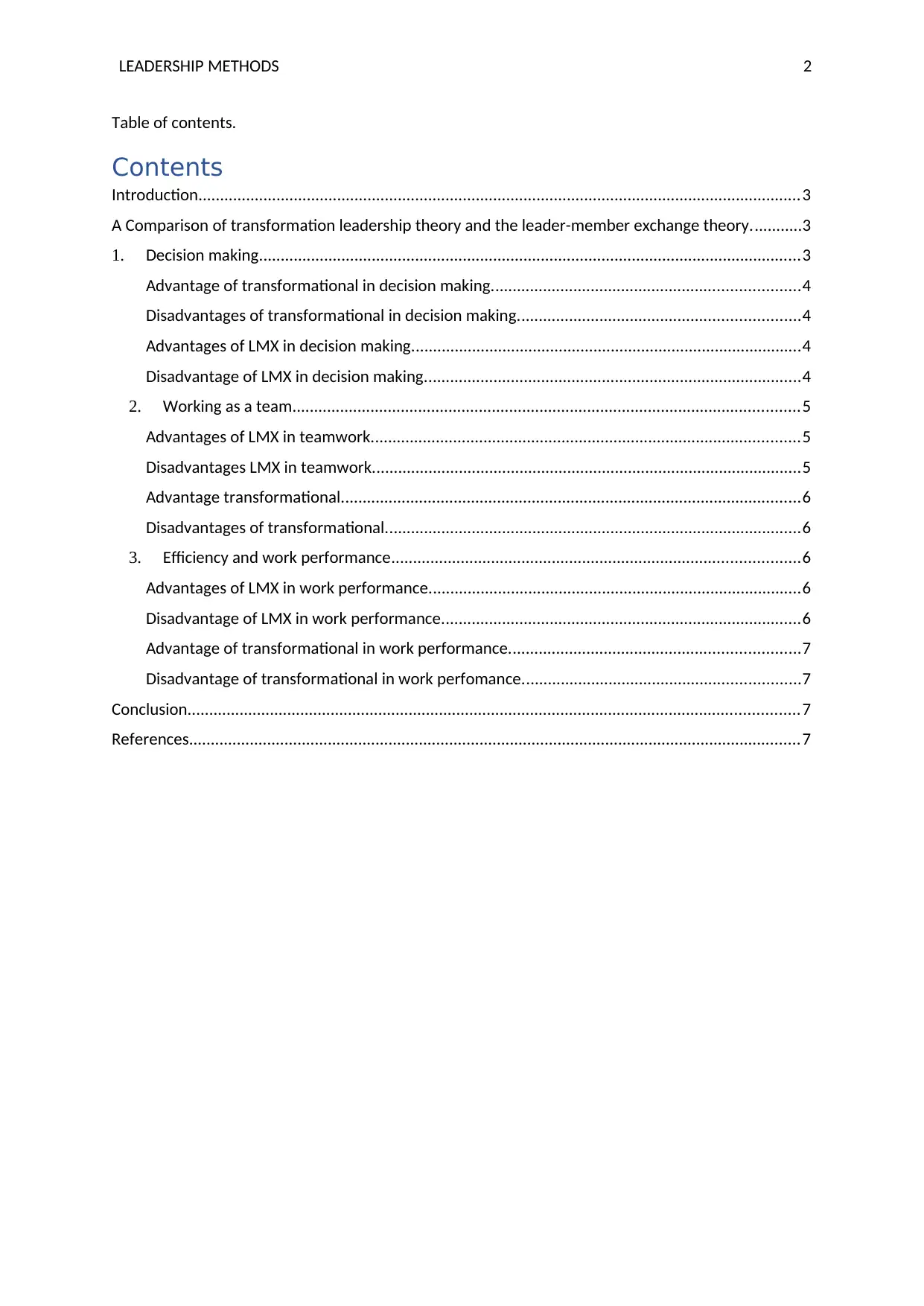
LEADERSHIP METHODS 2
Table of contents.
Contents
Introduction...........................................................................................................................................3
A Comparison of transformation leadership theory and the leader-member exchange theory............3
1. Decision making.............................................................................................................................3
Advantage of transformational in decision making.......................................................................4
Disadvantages of transformational in decision making.................................................................4
Advantages of LMX in decision making..........................................................................................4
Disadvantage of LMX in decision making.......................................................................................4
2. Working as a team.....................................................................................................................5
Advantages of LMX in teamwork...................................................................................................5
Disadvantages LMX in teamwork...................................................................................................5
Advantage transformational..........................................................................................................6
Disadvantages of transformational................................................................................................6
3. Efficiency and work performance..............................................................................................6
Advantages of LMX in work performance......................................................................................6
Disadvantage of LMX in work performance...................................................................................6
Advantage of transformational in work performance...................................................................7
Disadvantage of transformational in work perfomance................................................................7
Conclusion.............................................................................................................................................7
References.............................................................................................................................................7
Table of contents.
Contents
Introduction...........................................................................................................................................3
A Comparison of transformation leadership theory and the leader-member exchange theory............3
1. Decision making.............................................................................................................................3
Advantage of transformational in decision making.......................................................................4
Disadvantages of transformational in decision making.................................................................4
Advantages of LMX in decision making..........................................................................................4
Disadvantage of LMX in decision making.......................................................................................4
2. Working as a team.....................................................................................................................5
Advantages of LMX in teamwork...................................................................................................5
Disadvantages LMX in teamwork...................................................................................................5
Advantage transformational..........................................................................................................6
Disadvantages of transformational................................................................................................6
3. Efficiency and work performance..............................................................................................6
Advantages of LMX in work performance......................................................................................6
Disadvantage of LMX in work performance...................................................................................6
Advantage of transformational in work performance...................................................................7
Disadvantage of transformational in work perfomance................................................................7
Conclusion.............................................................................................................................................7
References.............................................................................................................................................7
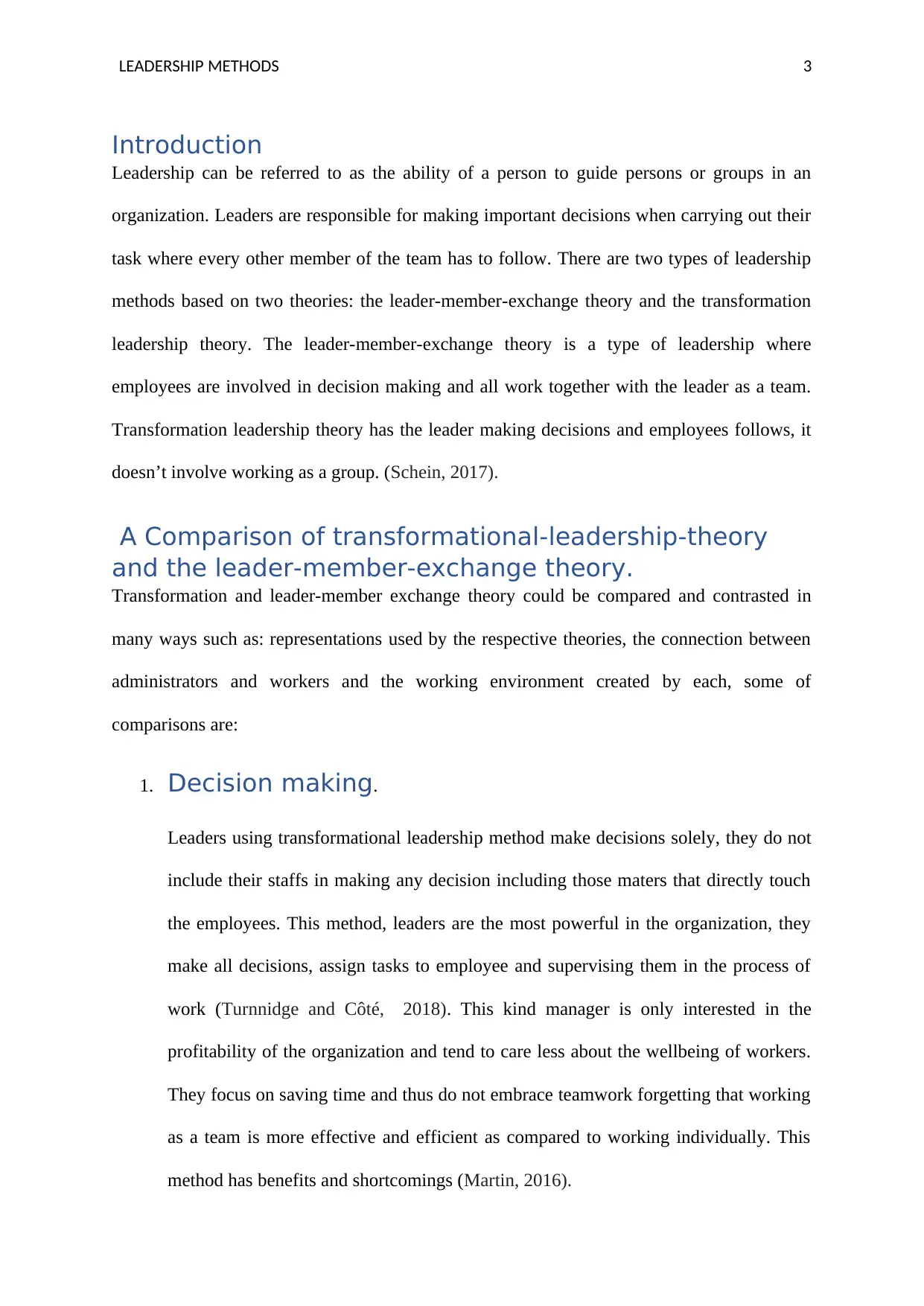
LEADERSHIP METHODS 3
Introduction
Leadership can be referred to as the ability of a person to guide persons or groups in an
organization. Leaders are responsible for making important decisions when carrying out their
task where every other member of the team has to follow. There are two types of leadership
methods based on two theories: the leader-member-exchange theory and the transformation
leadership theory. The leader-member-exchange theory is a type of leadership where
employees are involved in decision making and all work together with the leader as a team.
Transformation leadership theory has the leader making decisions and employees follows, it
doesn’t involve working as a group. (Schein, 2017).
A Comparison of transformational-leadership-theory
and the leader-member-exchange theory.
Transformation and leader-member exchange theory could be compared and contrasted in
many ways such as: representations used by the respective theories, the connection between
administrators and workers and the working environment created by each, some of
comparisons are:
1. Decision making.
Leaders using transformational leadership method make decisions solely, they do not
include their staffs in making any decision including those maters that directly touch
the employees. This method, leaders are the most powerful in the organization, they
make all decisions, assign tasks to employee and supervising them in the process of
work (Turnnidge and Côté, 2018). This kind manager is only interested in the
profitability of the organization and tend to care less about the wellbeing of workers.
They focus on saving time and thus do not embrace teamwork forgetting that working
as a team is more effective and efficient as compared to working individually. This
method has benefits and shortcomings (Martin, 2016).
Introduction
Leadership can be referred to as the ability of a person to guide persons or groups in an
organization. Leaders are responsible for making important decisions when carrying out their
task where every other member of the team has to follow. There are two types of leadership
methods based on two theories: the leader-member-exchange theory and the transformation
leadership theory. The leader-member-exchange theory is a type of leadership where
employees are involved in decision making and all work together with the leader as a team.
Transformation leadership theory has the leader making decisions and employees follows, it
doesn’t involve working as a group. (Schein, 2017).
A Comparison of transformational-leadership-theory
and the leader-member-exchange theory.
Transformation and leader-member exchange theory could be compared and contrasted in
many ways such as: representations used by the respective theories, the connection between
administrators and workers and the working environment created by each, some of
comparisons are:
1. Decision making.
Leaders using transformational leadership method make decisions solely, they do not
include their staffs in making any decision including those maters that directly touch
the employees. This method, leaders are the most powerful in the organization, they
make all decisions, assign tasks to employee and supervising them in the process of
work (Turnnidge and Côté, 2018). This kind manager is only interested in the
profitability of the organization and tend to care less about the wellbeing of workers.
They focus on saving time and thus do not embrace teamwork forgetting that working
as a team is more effective and efficient as compared to working individually. This
method has benefits and shortcomings (Martin, 2016).
⊘ This is a preview!⊘
Do you want full access?
Subscribe today to unlock all pages.

Trusted by 1+ million students worldwide
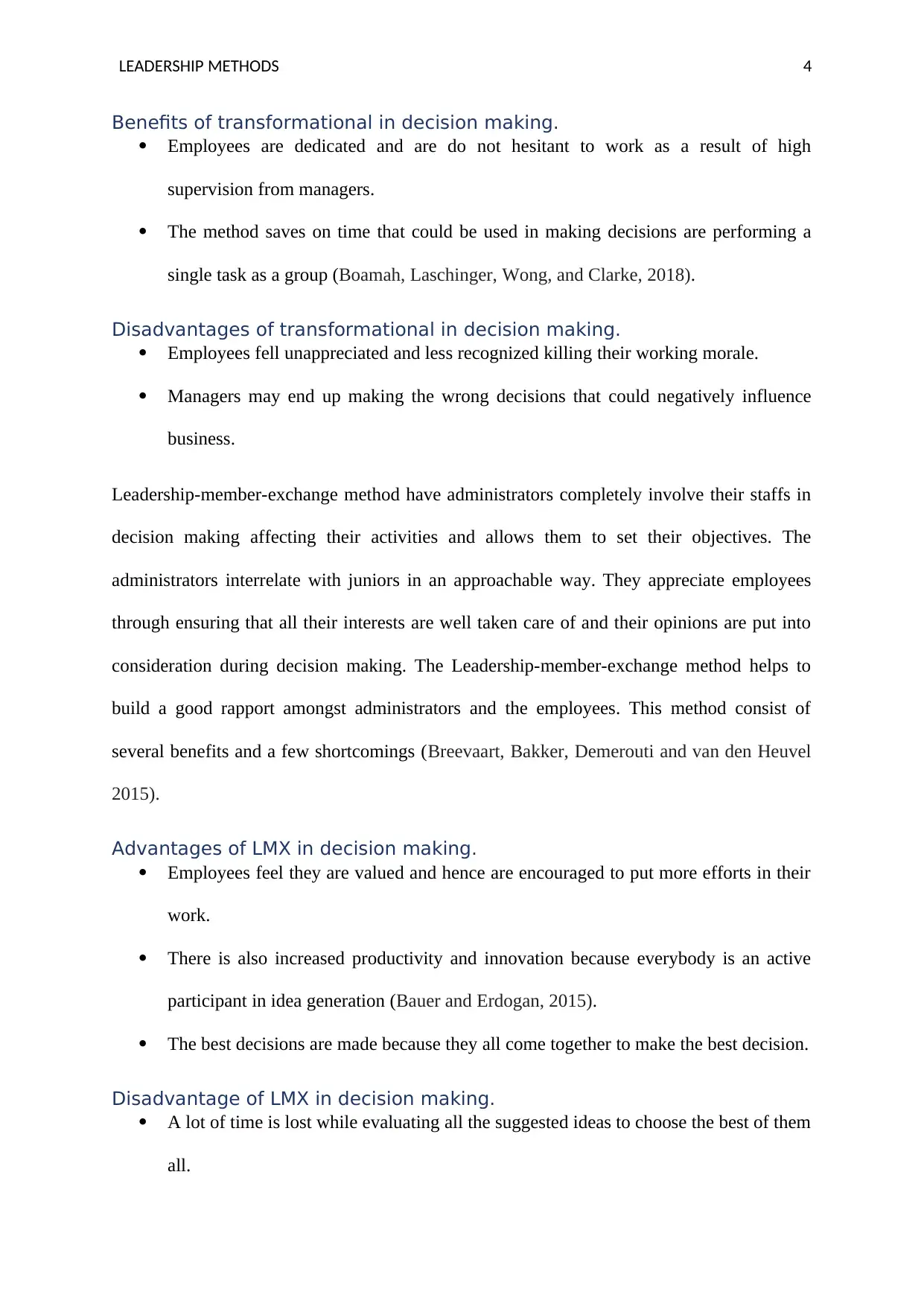
LEADERSHIP METHODS 4
Benefits of transformational in decision making.
Employees are dedicated and are do not hesitant to work as a result of high
supervision from managers.
The method saves on time that could be used in making decisions are performing a
single task as a group (Boamah, Laschinger, Wong, and Clarke, 2018).
Disadvantages of transformational in decision making.
Employees fell unappreciated and less recognized killing their working morale.
Managers may end up making the wrong decisions that could negatively influence
business.
Leadership-member-exchange method have administrators completely involve their staffs in
decision making affecting their activities and allows them to set their objectives. The
administrators interrelate with juniors in an approachable way. They appreciate employees
through ensuring that all their interests are well taken care of and their opinions are put into
consideration during decision making. The Leadership-member-exchange method helps to
build a good rapport amongst administrators and the employees. This method consist of
several benefits and a few shortcomings (Breevaart, Bakker, Demerouti and van den Heuvel
2015).
Advantages of LMX in decision making.
Employees feel they are valued and hence are encouraged to put more efforts in their
work.
There is also increased productivity and innovation because everybody is an active
participant in idea generation (Bauer and Erdogan, 2015).
The best decisions are made because they all come together to make the best decision.
Disadvantage of LMX in decision making.
A lot of time is lost while evaluating all the suggested ideas to choose the best of them
all.
Benefits of transformational in decision making.
Employees are dedicated and are do not hesitant to work as a result of high
supervision from managers.
The method saves on time that could be used in making decisions are performing a
single task as a group (Boamah, Laschinger, Wong, and Clarke, 2018).
Disadvantages of transformational in decision making.
Employees fell unappreciated and less recognized killing their working morale.
Managers may end up making the wrong decisions that could negatively influence
business.
Leadership-member-exchange method have administrators completely involve their staffs in
decision making affecting their activities and allows them to set their objectives. The
administrators interrelate with juniors in an approachable way. They appreciate employees
through ensuring that all their interests are well taken care of and their opinions are put into
consideration during decision making. The Leadership-member-exchange method helps to
build a good rapport amongst administrators and the employees. This method consist of
several benefits and a few shortcomings (Breevaart, Bakker, Demerouti and van den Heuvel
2015).
Advantages of LMX in decision making.
Employees feel they are valued and hence are encouraged to put more efforts in their
work.
There is also increased productivity and innovation because everybody is an active
participant in idea generation (Bauer and Erdogan, 2015).
The best decisions are made because they all come together to make the best decision.
Disadvantage of LMX in decision making.
A lot of time is lost while evaluating all the suggested ideas to choose the best of them
all.
Paraphrase This Document
Need a fresh take? Get an instant paraphrase of this document with our AI Paraphraser
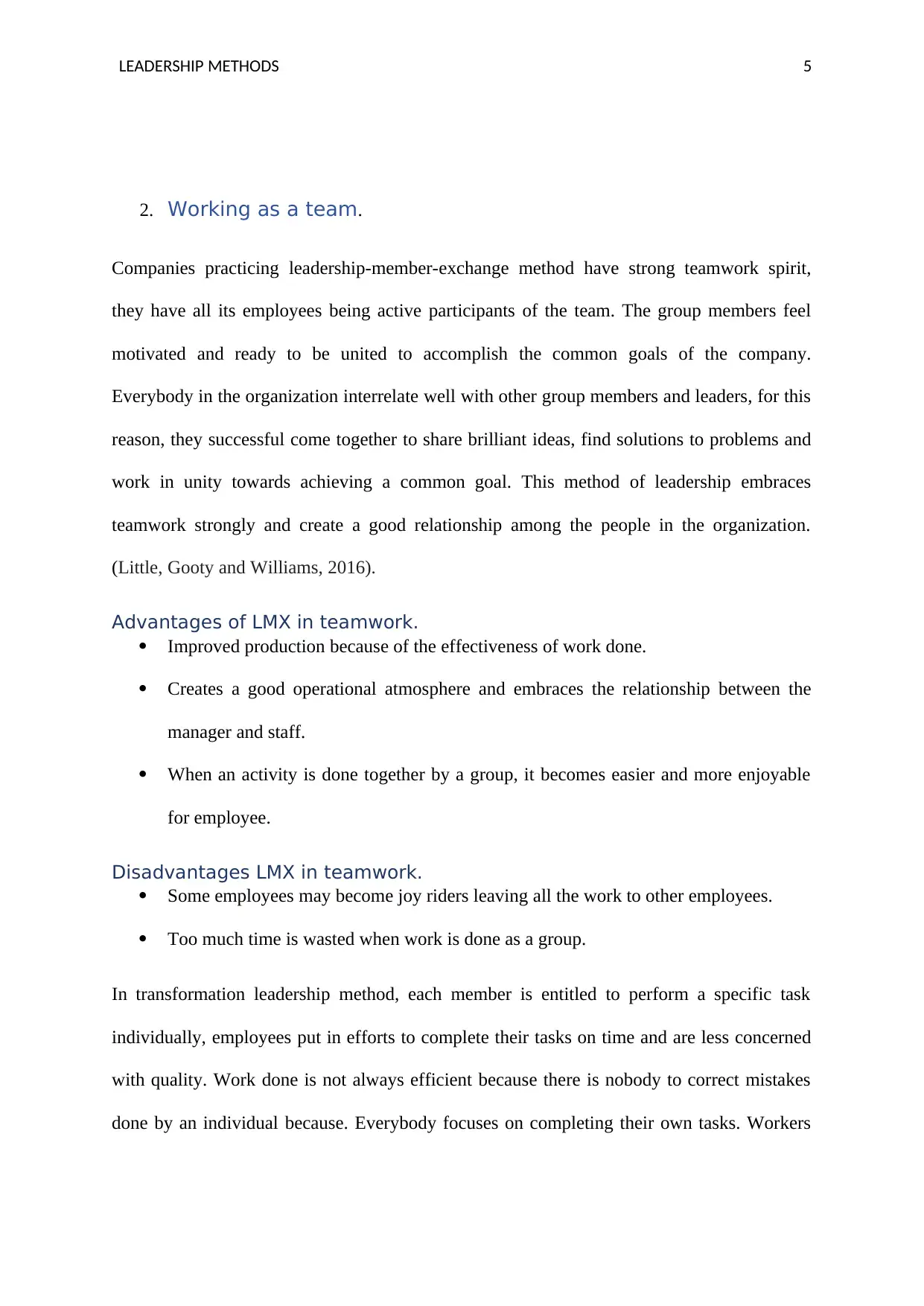
LEADERSHIP METHODS 5
2. Working as a team.
Companies practicing leadership-member-exchange method have strong teamwork spirit,
they have all its employees being active participants of the team. The group members feel
motivated and ready to be united to accomplish the common goals of the company.
Everybody in the organization interrelate well with other group members and leaders, for this
reason, they successful come together to share brilliant ideas, find solutions to problems and
work in unity towards achieving a common goal. This method of leadership embraces
teamwork strongly and create a good relationship among the people in the organization.
(Little, Gooty and Williams, 2016).
Advantages of LMX in teamwork.
Improved production because of the effectiveness of work done.
Creates a good operational atmosphere and embraces the relationship between the
manager and staff.
When an activity is done together by a group, it becomes easier and more enjoyable
for employee.
Disadvantages LMX in teamwork.
Some employees may become joy riders leaving all the work to other employees.
Too much time is wasted when work is done as a group.
In transformation leadership method, each member is entitled to perform a specific task
individually, employees put in efforts to complete their tasks on time and are less concerned
with quality. Work done is not always efficient because there is nobody to correct mistakes
done by an individual because. Everybody focuses on completing their own tasks. Workers
2. Working as a team.
Companies practicing leadership-member-exchange method have strong teamwork spirit,
they have all its employees being active participants of the team. The group members feel
motivated and ready to be united to accomplish the common goals of the company.
Everybody in the organization interrelate well with other group members and leaders, for this
reason, they successful come together to share brilliant ideas, find solutions to problems and
work in unity towards achieving a common goal. This method of leadership embraces
teamwork strongly and create a good relationship among the people in the organization.
(Little, Gooty and Williams, 2016).
Advantages of LMX in teamwork.
Improved production because of the effectiveness of work done.
Creates a good operational atmosphere and embraces the relationship between the
manager and staff.
When an activity is done together by a group, it becomes easier and more enjoyable
for employee.
Disadvantages LMX in teamwork.
Some employees may become joy riders leaving all the work to other employees.
Too much time is wasted when work is done as a group.
In transformation leadership method, each member is entitled to perform a specific task
individually, employees put in efforts to complete their tasks on time and are less concerned
with quality. Work done is not always efficient because there is nobody to correct mistakes
done by an individual because. Everybody focuses on completing their own tasks. Workers
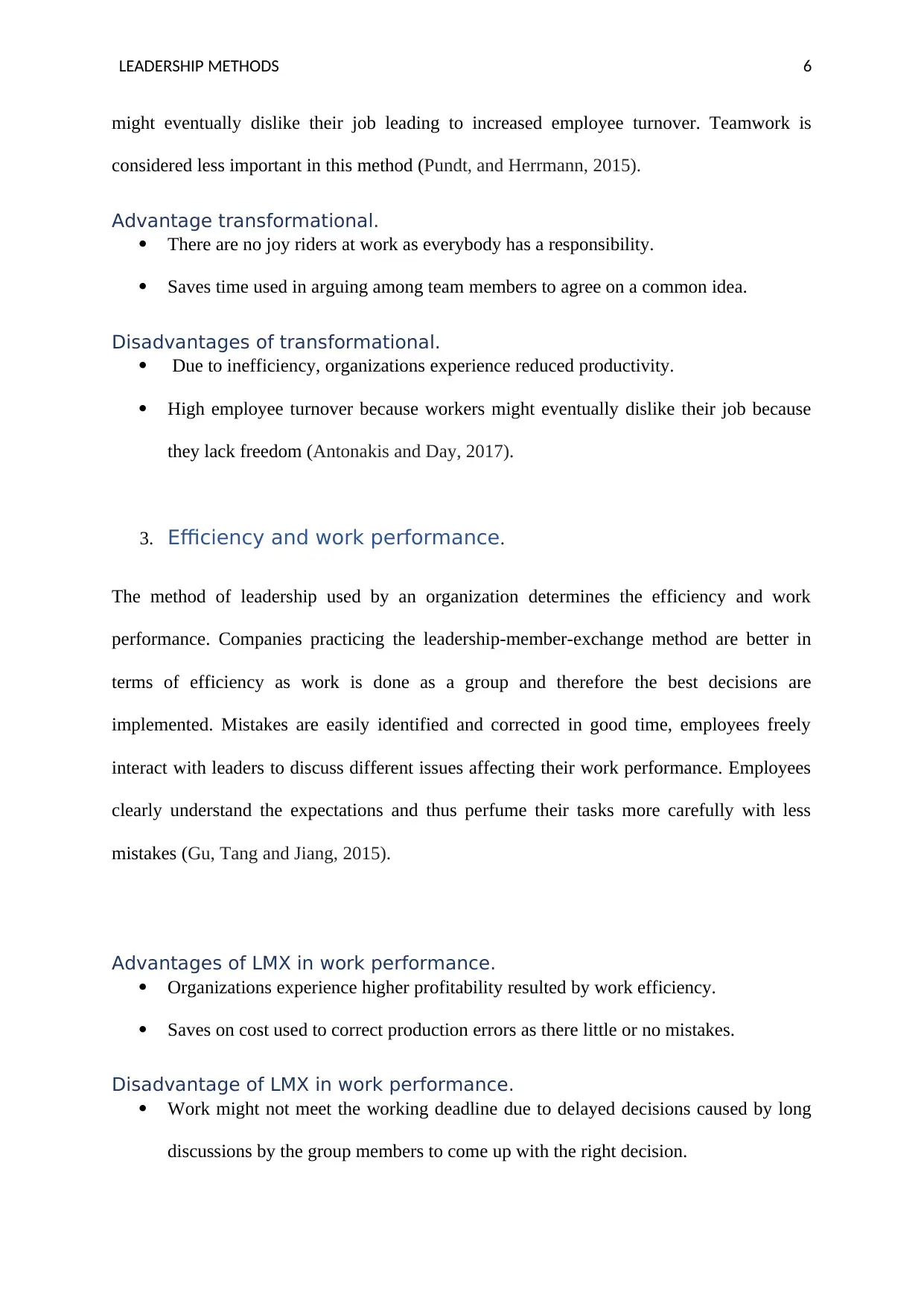
LEADERSHIP METHODS 6
might eventually dislike their job leading to increased employee turnover. Teamwork is
considered less important in this method (Pundt, and Herrmann, 2015).
Advantage transformational.
There are no joy riders at work as everybody has a responsibility.
Saves time used in arguing among team members to agree on a common idea.
Disadvantages of transformational.
Due to inefficiency, organizations experience reduced productivity.
High employee turnover because workers might eventually dislike their job because
they lack freedom (Antonakis and Day, 2017).
3. Efficiency and work performance.
The method of leadership used by an organization determines the efficiency and work
performance. Companies practicing the leadership-member-exchange method are better in
terms of efficiency as work is done as a group and therefore the best decisions are
implemented. Mistakes are easily identified and corrected in good time, employees freely
interact with leaders to discuss different issues affecting their work performance. Employees
clearly understand the expectations and thus perfume their tasks more carefully with less
mistakes (Gu, Tang and Jiang, 2015).
Advantages of LMX in work performance.
Organizations experience higher profitability resulted by work efficiency.
Saves on cost used to correct production errors as there little or no mistakes.
Disadvantage of LMX in work performance.
Work might not meet the working deadline due to delayed decisions caused by long
discussions by the group members to come up with the right decision.
might eventually dislike their job leading to increased employee turnover. Teamwork is
considered less important in this method (Pundt, and Herrmann, 2015).
Advantage transformational.
There are no joy riders at work as everybody has a responsibility.
Saves time used in arguing among team members to agree on a common idea.
Disadvantages of transformational.
Due to inefficiency, organizations experience reduced productivity.
High employee turnover because workers might eventually dislike their job because
they lack freedom (Antonakis and Day, 2017).
3. Efficiency and work performance.
The method of leadership used by an organization determines the efficiency and work
performance. Companies practicing the leadership-member-exchange method are better in
terms of efficiency as work is done as a group and therefore the best decisions are
implemented. Mistakes are easily identified and corrected in good time, employees freely
interact with leaders to discuss different issues affecting their work performance. Employees
clearly understand the expectations and thus perfume their tasks more carefully with less
mistakes (Gu, Tang and Jiang, 2015).
Advantages of LMX in work performance.
Organizations experience higher profitability resulted by work efficiency.
Saves on cost used to correct production errors as there little or no mistakes.
Disadvantage of LMX in work performance.
Work might not meet the working deadline due to delayed decisions caused by long
discussions by the group members to come up with the right decision.
⊘ This is a preview!⊘
Do you want full access?
Subscribe today to unlock all pages.

Trusted by 1+ million students worldwide
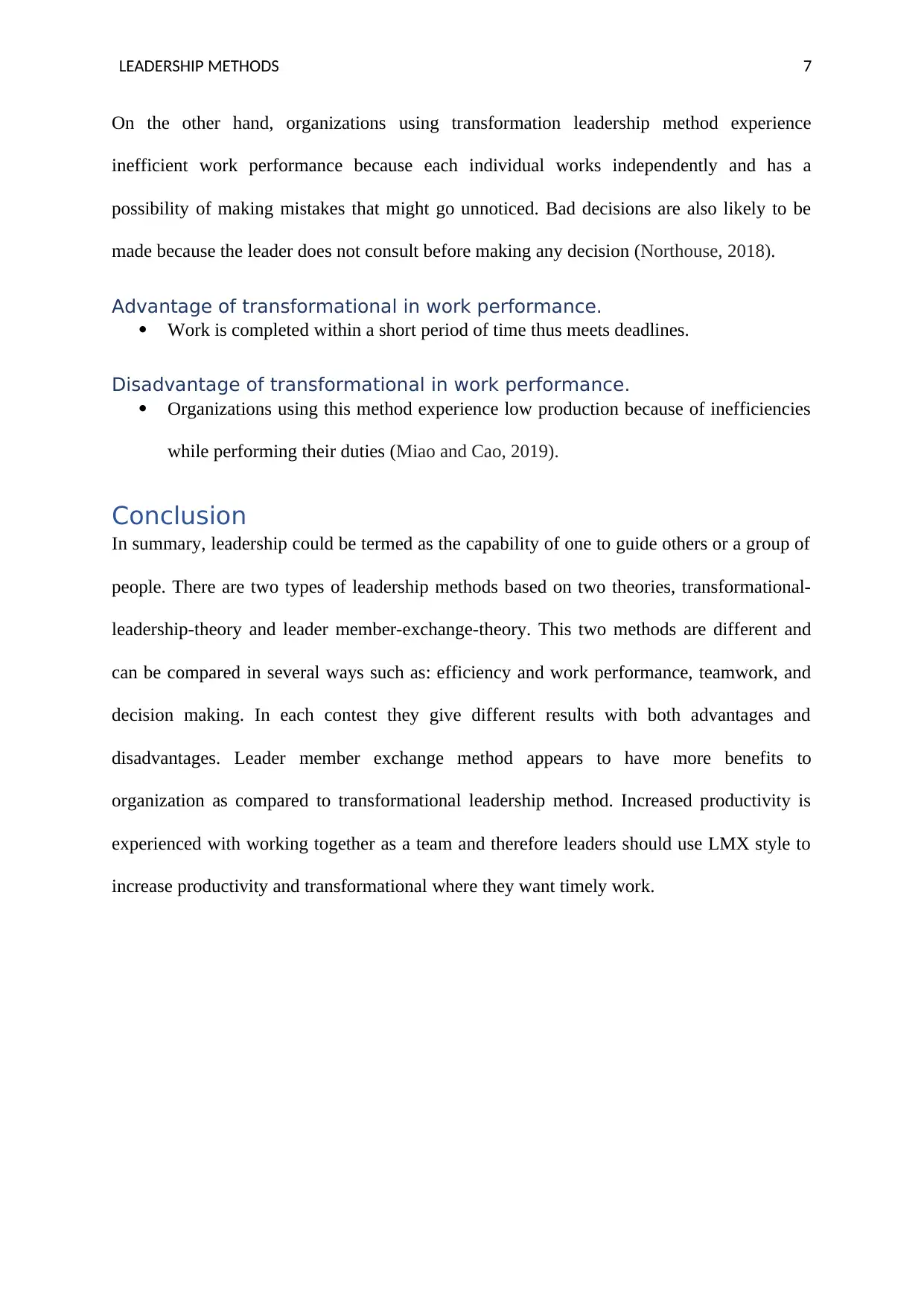
LEADERSHIP METHODS 7
On the other hand, organizations using transformation leadership method experience
inefficient work performance because each individual works independently and has a
possibility of making mistakes that might go unnoticed. Bad decisions are also likely to be
made because the leader does not consult before making any decision (Northouse, 2018).
Advantage of transformational in work performance.
Work is completed within a short period of time thus meets deadlines.
Disadvantage of transformational in work performance.
Organizations using this method experience low production because of inefficiencies
while performing their duties (Miao and Cao, 2019).
Conclusion
In summary, leadership could be termed as the capability of one to guide others or a group of
people. There are two types of leadership methods based on two theories, transformational-
leadership-theory and leader member-exchange-theory. This two methods are different and
can be compared in several ways such as: efficiency and work performance, teamwork, and
decision making. In each contest they give different results with both advantages and
disadvantages. Leader member exchange method appears to have more benefits to
organization as compared to transformational leadership method. Increased productivity is
experienced with working together as a team and therefore leaders should use LMX style to
increase productivity and transformational where they want timely work.
On the other hand, organizations using transformation leadership method experience
inefficient work performance because each individual works independently and has a
possibility of making mistakes that might go unnoticed. Bad decisions are also likely to be
made because the leader does not consult before making any decision (Northouse, 2018).
Advantage of transformational in work performance.
Work is completed within a short period of time thus meets deadlines.
Disadvantage of transformational in work performance.
Organizations using this method experience low production because of inefficiencies
while performing their duties (Miao and Cao, 2019).
Conclusion
In summary, leadership could be termed as the capability of one to guide others or a group of
people. There are two types of leadership methods based on two theories, transformational-
leadership-theory and leader member-exchange-theory. This two methods are different and
can be compared in several ways such as: efficiency and work performance, teamwork, and
decision making. In each contest they give different results with both advantages and
disadvantages. Leader member exchange method appears to have more benefits to
organization as compared to transformational leadership method. Increased productivity is
experienced with working together as a team and therefore leaders should use LMX style to
increase productivity and transformational where they want timely work.
Paraphrase This Document
Need a fresh take? Get an instant paraphrase of this document with our AI Paraphraser
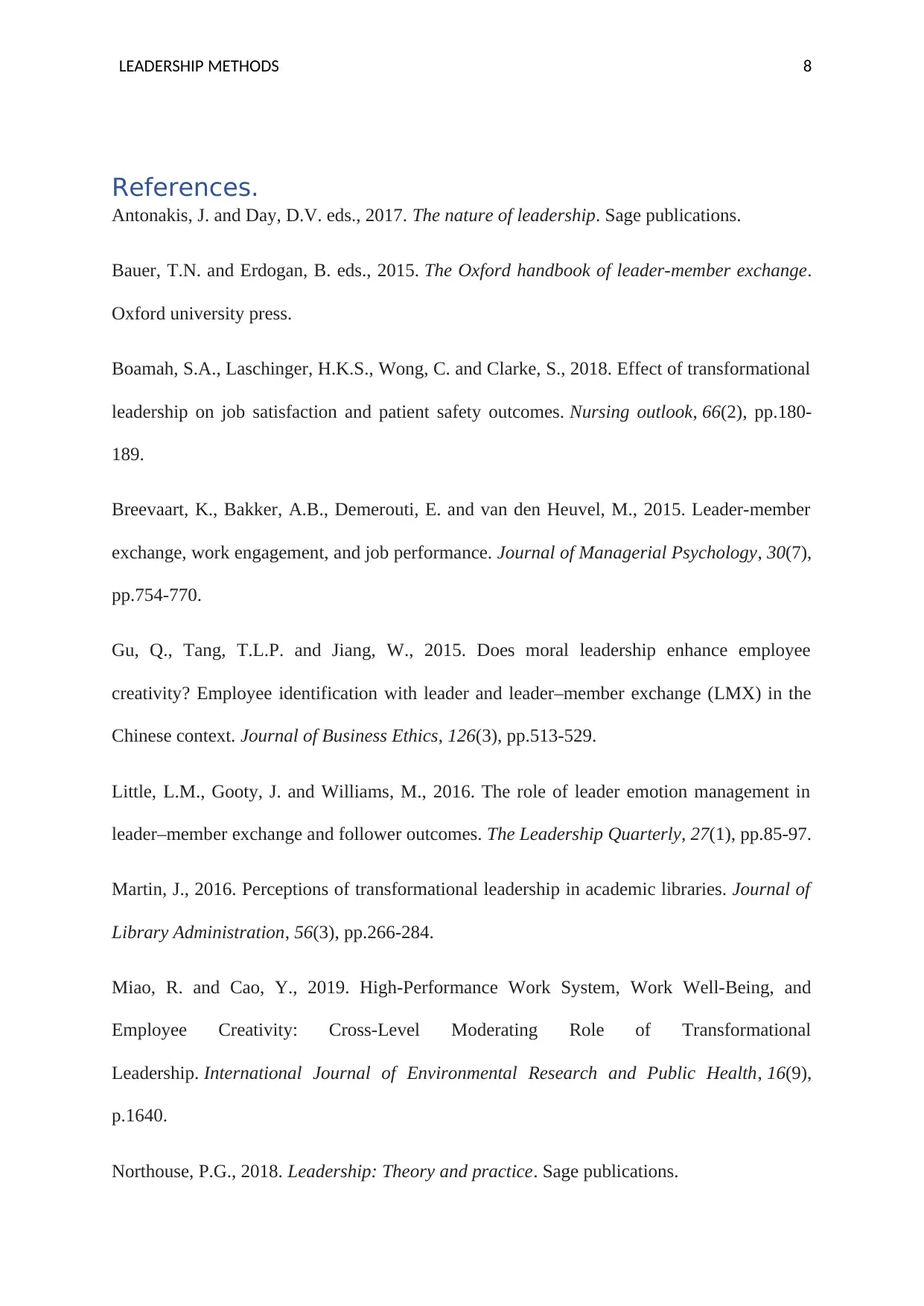
LEADERSHIP METHODS 8
References.
Antonakis, J. and Day, D.V. eds., 2017. The nature of leadership. Sage publications.
Bauer, T.N. and Erdogan, B. eds., 2015. The Oxford handbook of leader-member exchange.
Oxford university press.
Boamah, S.A., Laschinger, H.K.S., Wong, C. and Clarke, S., 2018. Effect of transformational
leadership on job satisfaction and patient safety outcomes. Nursing outlook, 66(2), pp.180-
189.
Breevaart, K., Bakker, A.B., Demerouti, E. and van den Heuvel, M., 2015. Leader-member
exchange, work engagement, and job performance. Journal of Managerial Psychology, 30(7),
pp.754-770.
Gu, Q., Tang, T.L.P. and Jiang, W., 2015. Does moral leadership enhance employee
creativity? Employee identification with leader and leader–member exchange (LMX) in the
Chinese context. Journal of Business Ethics, 126(3), pp.513-529.
Little, L.M., Gooty, J. and Williams, M., 2016. The role of leader emotion management in
leader–member exchange and follower outcomes. The Leadership Quarterly, 27(1), pp.85-97.
Martin, J., 2016. Perceptions of transformational leadership in academic libraries. Journal of
Library Administration, 56(3), pp.266-284.
Miao, R. and Cao, Y., 2019. High-Performance Work System, Work Well-Being, and
Employee Creativity: Cross-Level Moderating Role of Transformational
Leadership. International Journal of Environmental Research and Public Health, 16(9),
p.1640.
Northouse, P.G., 2018. Leadership: Theory and practice. Sage publications.
References.
Antonakis, J. and Day, D.V. eds., 2017. The nature of leadership. Sage publications.
Bauer, T.N. and Erdogan, B. eds., 2015. The Oxford handbook of leader-member exchange.
Oxford university press.
Boamah, S.A., Laschinger, H.K.S., Wong, C. and Clarke, S., 2018. Effect of transformational
leadership on job satisfaction and patient safety outcomes. Nursing outlook, 66(2), pp.180-
189.
Breevaart, K., Bakker, A.B., Demerouti, E. and van den Heuvel, M., 2015. Leader-member
exchange, work engagement, and job performance. Journal of Managerial Psychology, 30(7),
pp.754-770.
Gu, Q., Tang, T.L.P. and Jiang, W., 2015. Does moral leadership enhance employee
creativity? Employee identification with leader and leader–member exchange (LMX) in the
Chinese context. Journal of Business Ethics, 126(3), pp.513-529.
Little, L.M., Gooty, J. and Williams, M., 2016. The role of leader emotion management in
leader–member exchange and follower outcomes. The Leadership Quarterly, 27(1), pp.85-97.
Martin, J., 2016. Perceptions of transformational leadership in academic libraries. Journal of
Library Administration, 56(3), pp.266-284.
Miao, R. and Cao, Y., 2019. High-Performance Work System, Work Well-Being, and
Employee Creativity: Cross-Level Moderating Role of Transformational
Leadership. International Journal of Environmental Research and Public Health, 16(9),
p.1640.
Northouse, P.G., 2018. Leadership: Theory and practice. Sage publications.
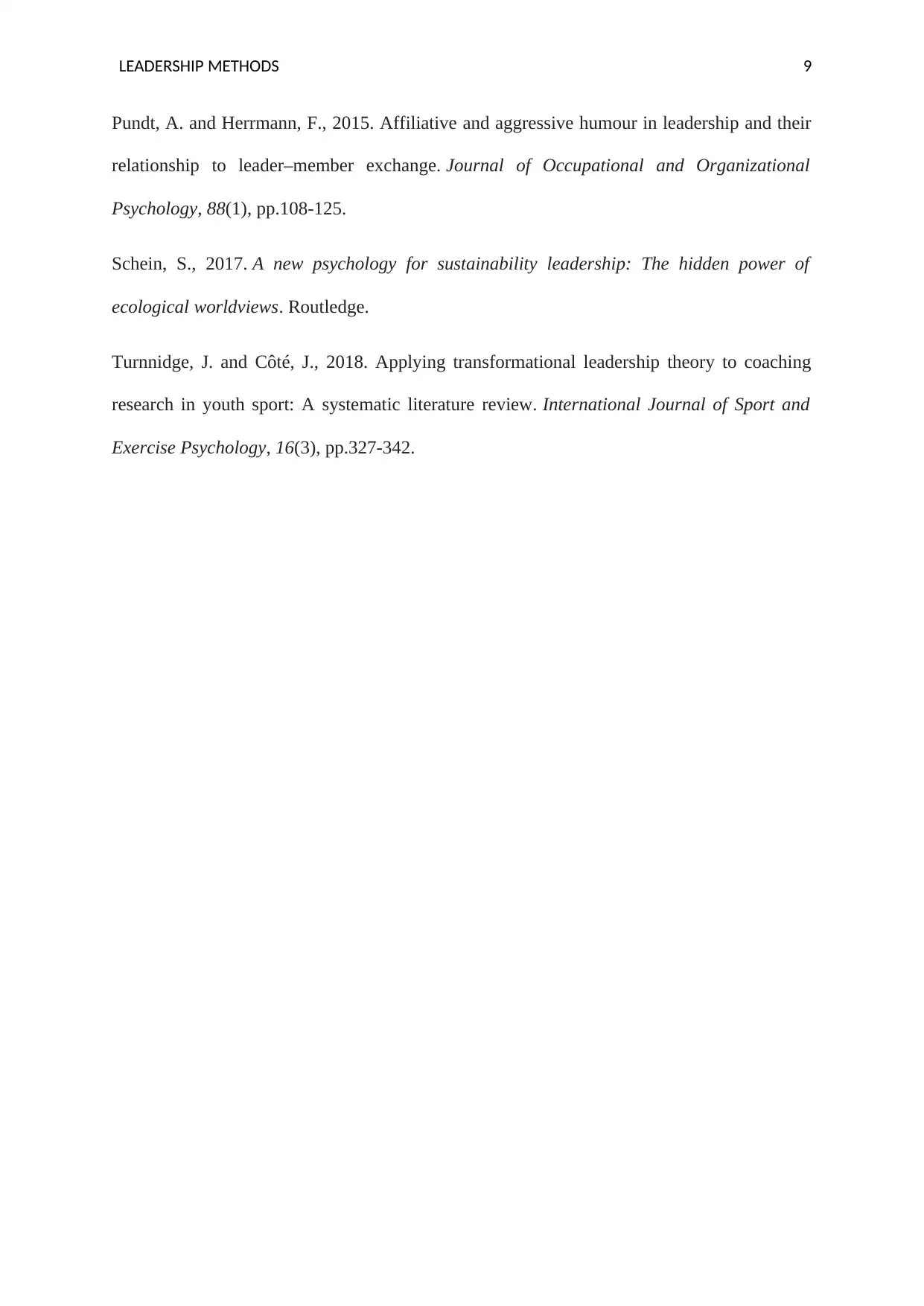
LEADERSHIP METHODS 9
Pundt, A. and Herrmann, F., 2015. Affiliative and aggressive humour in leadership and their
relationship to leader–member exchange. Journal of Occupational and Organizational
Psychology, 88(1), pp.108-125.
Schein, S., 2017. A new psychology for sustainability leadership: The hidden power of
ecological worldviews. Routledge.
Turnnidge, J. and Côté, J., 2018. Applying transformational leadership theory to coaching
research in youth sport: A systematic literature review. International Journal of Sport and
Exercise Psychology, 16(3), pp.327-342.
Pundt, A. and Herrmann, F., 2015. Affiliative and aggressive humour in leadership and their
relationship to leader–member exchange. Journal of Occupational and Organizational
Psychology, 88(1), pp.108-125.
Schein, S., 2017. A new psychology for sustainability leadership: The hidden power of
ecological worldviews. Routledge.
Turnnidge, J. and Côté, J., 2018. Applying transformational leadership theory to coaching
research in youth sport: A systematic literature review. International Journal of Sport and
Exercise Psychology, 16(3), pp.327-342.
⊘ This is a preview!⊘
Do you want full access?
Subscribe today to unlock all pages.

Trusted by 1+ million students worldwide
1 out of 9
Related Documents
Your All-in-One AI-Powered Toolkit for Academic Success.
+13062052269
info@desklib.com
Available 24*7 on WhatsApp / Email
![[object Object]](/_next/static/media/star-bottom.7253800d.svg)
Unlock your academic potential
Copyright © 2020–2025 A2Z Services. All Rights Reserved. Developed and managed by ZUCOL.




